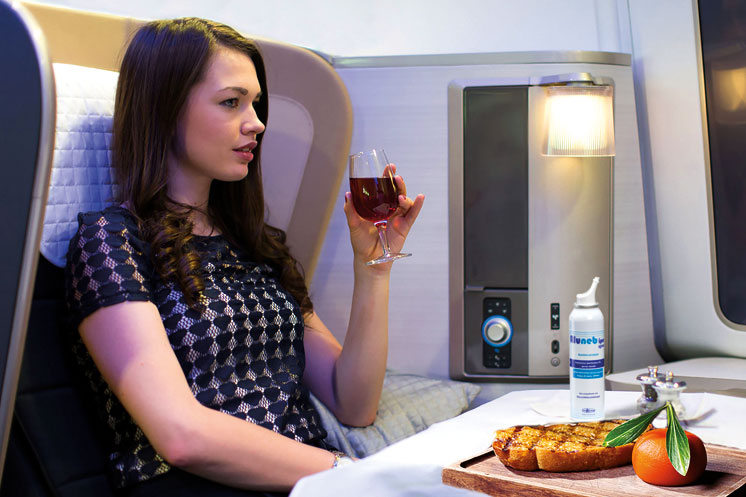Smother it with sauce, serve it with shiraz, pass the salt: it’s a case of reheat and repeat down the back of the plane.
A lifetime ago, I was flying across Russia’s Caucasus mountains on a route that no longer exists, on an airline that has since gone out of business. There were, perhaps, a dozen of us on the creaking, leaking Russian-owned plane from Vladikavkaz to Sochi. The cabin crew paused only in their cosmetics application to curl hot-pink lips into a snarl and deliver water and a dry cracker on request.
Save the low passenger numbers, you could well mistake that flaccid food service for any domestic economy Australian flight, where grey-suited businessmen and toddlers alike are to be found morosely gumming perky, Smartie-covered cookies thanks to the miserly accountants on their cost-cutting committees. Unless, of course, you’re up at the hush-hush, wrap-me-in-cotton-wool, pointy end of the plane.
It’s a far cry from the Golden Age of Travel, where brightly coloured vintage postcards show white-clad chefs whipping cloches away to reveal platters of beautiful, freshly prepared food, although I’m imagining a fair bit of aspic going on there, with the special ambience that only menthol cigarette smoke can bring.
Admittedly, we no longer have to sell a kidney to fly across the world, and when we do fly, it’s a whole lot faster. What’s also changed since the 1950s (apart from the advent of crevice-hugging sportswear as the preferred wardrobe option) is the science of eating at 30,000 feet. German carrier Lufthansa discovered a third of our tastebuds pack their bags the minute the doors close and the cabin crew start sashaying toward the emergency exits.
One-third. Who doesn’t love an easy statistic? Even I can remember that. Add to that a high-altitude blocked nose and it’s an incentive for fashionable fasting or an excuse to hit the bottle, remembering that one on the ground is two in the air. Airline chefs have taken the research on board and run with it: smother it with sauce, serve it with shiraz, pass the salt.
Some national carriers, who naturally showcase their countries’ signature dishes, didn’t need the research. Bhutan, whose own Drukair is the only
airline to fly into the tiny Himalayan nation, uses chillies as its main vegetable, and salt as its preferred seasoning. Meat or other vegetables make the odd, cameo performance. Druk didn’t need the memo about serving inflight food hot and strong. Its main course, ema datse (chilli with cheese), served up with a foil-sealed cup of sticky reconstituted orange juice, is still burnt into my gut lining as a memorable dish, and not necessarily for the right reasons. ‘You don’t go to Bhutan for the food,’ old Bhutan hands warned me, and they were right.
Yet other countries that really should know better still choose to massacre their national cuisine in the name of ‘airline food’. Languid salads, malnourished noodles married with sedated, deflated chicken and the old powdered-eggs-and-potato combo have long been the cattle class go-to from even the world’s top carriers. When in doubt, the Middle Eastern carriers just add sugar. I know, up the front, they’re pulling out the Bollinger, the air chefs are rattling the sauté pans and I can smell the espresso machine working, but the travesties are happening past the iron curtain, back in economy.
There are, of course, the shining stars who pop up in the most unexpected places. What dark magic does Turkish Airlines weave to deliver its delicious, distinctive cuisine – toothsome kebabs, spry salads, hot flat bread and potable juice? A little kebab stand hidden in the galley? It’s no wonder the airline is a constant at the top of the airline food awards lists. This year it hit six consecutive years as Skytrax’ Best Airline in Europe.
It even wooed Kevin Costner and, more recently, Morgan Freeman to star in its ads, in one of the more unexpected cases of ‘celebrities-making-a-quick-buck-overseas-while-America’s-not-looking’. But the most sensitive men in Hollywood obviously know what side their unleavened bread is buttered on.
Airlines have begged celebrity chefs to discover the secret. Virgin Australia has Luke Mangan, Joël Robuchon works with Air France; even Heston Blumenthal has stepped into British Airways’ galleys, brandishing nasal douching devices to reinvigorate fliers’ sense of smell. Have they made a difference? The seared steaks, the perfectly poached salmon, the purées and petits fours are going down well in the big end of town, where the corporates, the cashed-up and points players sit.
If economy travellers are lucky, some of that celebrity magic may even trickle down the aisles, albeit with only two choices (‘chicken or the veg?’). Otherwise, they all seem to subscribe to the theory that economy travellers’ tastebuds are already on the beach with a tinned piña colada by the time they hit cruising altitude.
But when it comes down to it, deep down in our dark hearts we know the low-cost airlines have got it right when they say that they’ll get us (and hopefully our luggage) there on time, and safely. The rest is just trimmings. Pass the cup of water, would you?



Comments are closed.